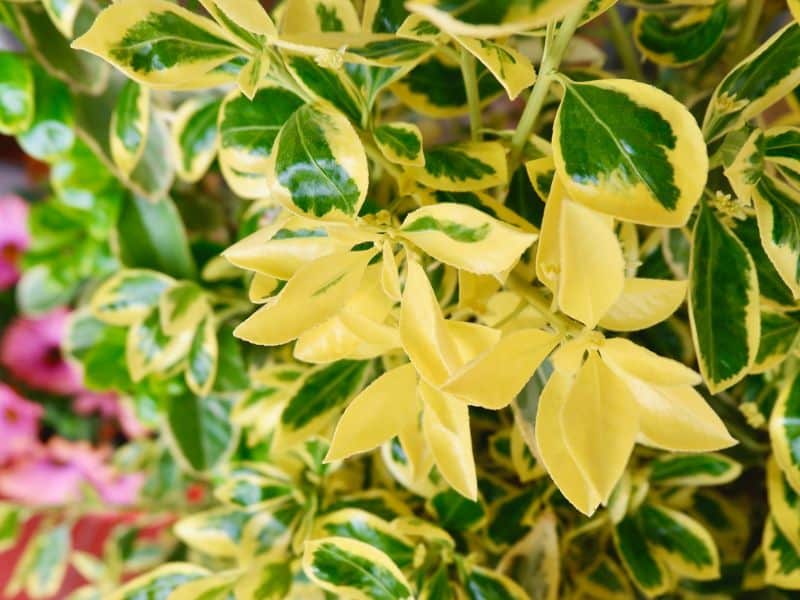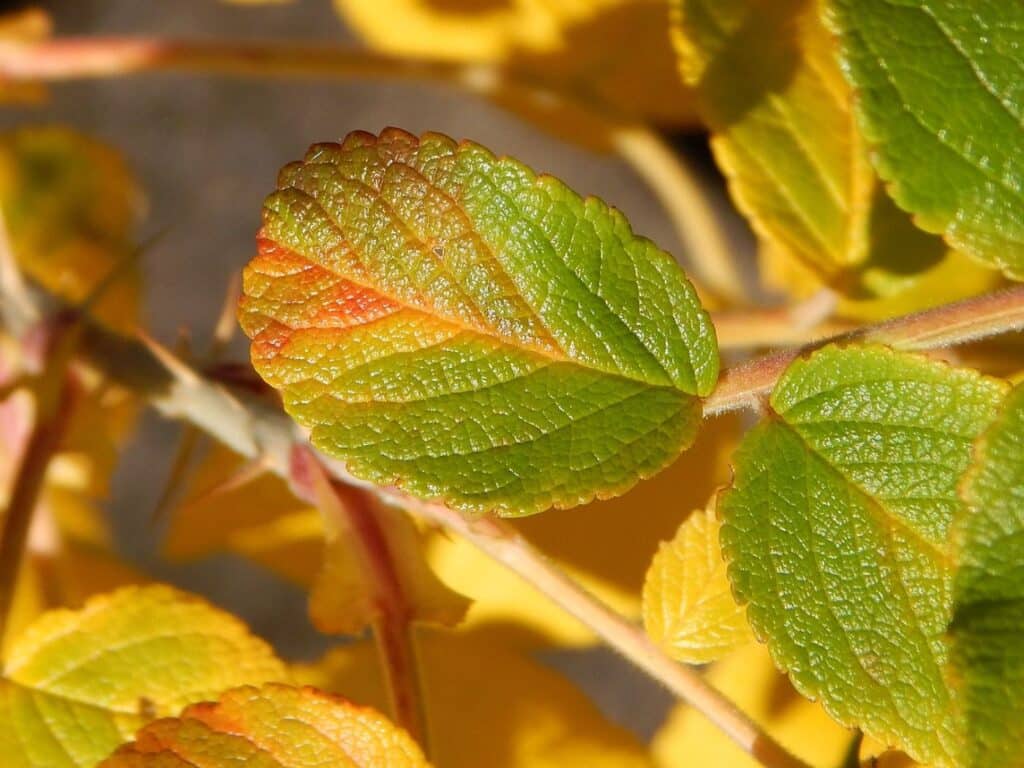Imagine walking into your living space, greeted by the lush greenery of your indoor houseplants, only to find that their leaves are turning yellow. It’s a sight that can dampen the spirits of even the most enthusiastic plant parents.
Yellowing leaves are more than just an aesthetic issue; they’re a distress signal from your plants, indicating that something’s amiss in their environment.
But don’t worry, you’re not alone in this. Yellow leaves are a common problem many indoor gardeners face, but the good news is, it’s often reversible. Identifying the cause is the first step to restoring your plants back to their vibrant selves.
In this article, we’ll guide you through the possible reasons behind the yellowing of indoor plant leaves and offer solutions to help you tackle this issue head-on. Let’s embark on this green journey together, ensuring your indoor oasis remains as thriving and healthy as you envisioned.
Understanding Why Indoor Plant Leaves Turn Yellow
Yellow leaves on your indoor plants can be a bit of a downer, signaling that all’s not right in plant paradise. Yet, getting to the bottom of this can turn things around and keep your leafy friends happy and healthy.
The Science of Chlorosis
Chlorosis, which sounds more like a dinosaur than a plant issue, actually refers to the yellowing of leaves due to insufficient chlorophyll. This crucial green pigment does more than just make plants look pretty; it’s essential for photosynthesis, the process plants use to turn sunlight into food.
When a plant can’t produce enough chlorophyll, its leaves start to yellow, signaling a cry for help. Various factors, like nutrient deficiencies or poor light exposure, can trigger this condition, highlighting the need for a quick response to get your plants back to their vibrant selves.
Common Environmental Stressors
Think of your plants as guests at a party you’re hosting. Just like guests may well not enjoy a party that’s too cold, too crowded, or lacking in food, plants react negatively to less-than-ideal conditions.
Overwatering and underwatering are the equivalent of offering your guests either a flood of drinks or none at all – both are unwelcome extremes. Similarly, plants need the right balance of light; too little sunlight is like keeping them in the dark about the fun happening outside, while too much sunlight can have them looking for shade.
Nutritional imbalances, like a diet lacking key vitamins or minerals, can also lead to yellowing leaves. Even the quality of water matters, with hard water potentially leaving plants feeling a bit “meh.”
Addressing these issues usually involves detective work and some trial and error. But, with a bit of attention and care, you can usually pinpoint the stressor causing yellow leaves and create a happier environment for your indoor garden.
Remember, plants don’t throw tantrums without reason; yellow leaves are their way of telling you something’s off. Listen closely, and they’ll guide you to the solution.
Watering Habits and Yellow Leaves

Overwatering Issues
Believe it or not, your love and care may well be a tad too much for your leafy friends. Overwatering is the most common mistake plant parents make, leading to yellow, limp leaves.
Plants need oxygen as much as they need water, and too much water suffocates the roots, preventing them from absorbing necessary nutrients. If the top inch of the soil feels soggy or if you see water standing in the saucer beneath the pot, you’ve probably been a bit overzealous with the watering can. Cut back on the aqua, and your plant’s foliage may well just return to its vibrant green self.
Underwatering Signs
On the flip side, if your plant’s leaves are turning yellow, crispy, and seem to be wilting, you may well be forgetting your watering duties. Plants rely on water to transport nutrients from the soil to their leaves, and without enough moisture, they can’t keep up their green appearance.
Check the soil of your indoor plants: if it feels dry several inches down or if the pot feels notably light, it’s time to up your watering game. Remember, it’s all about finding a happy medium – not too much, not too little.
Nutrient Deficiencies and Leaf Discoloration
When your indoor plants start sporting yellow leaves, nutrient deficiencies often play a significant role. Let’s dive into how a lack of specific nutrients can change the game for your green friends.
Nitrogen Shortage
Ever noticed your plant’s leaves turning yellow starting from the bottom? That’s a classic sign of nitrogen shortage. Nitrogen is a major player in chlorophyll production, which gives leaves their green color. Without enough nitrogen, your plants can’t photosynthesize properly, leading to yellowing leaves.
They’re basically screaming for a nutrient boost. Incorporating a nitrogen-rich fertilizer can turn things around, giving your plants the vibrant green leaves they deserve.
Other Essential Nutrients
While nitrogen grabs the spotlight, other nutrients are waiting in the wings, ready to cause yellow leaves if they’re missing. Iron, magnesium, and potassium deficiencies can also lead to discoloration.
Iron deficiency usually shows up as yellowing between the leaf veins. Magnesium shortage turns leaf edges yellow first.
And a lack of potassium? You’ll see yellow leaves with brown edges. It sounds like a detective game, but spotting these signs early can save your plants. A well-balanced fertilizer can address these deficiencies, helping keep your indoor garden lush and green.
Light Exposure and Its Effects on Indoor Plants
Too Much Sunlight
Getting too much sunlight can be just as problematic as not getting enough for your indoor plants. When leaves get bombarded with more light than they can handle, they may turn yellow or even get scorched, showing signs of burn.
Think of it like a plant’s version of a bad sunburn. To prevent this, monitor the light intensity in the room and consider relocating plants that seem to struggle with too much direct sunlight. Sometimes, a sheer curtain can be a game changer, diffusing the light just enough to keep your green friends happy.
Insufficient Light
On the flip side, not receiving enough light can lead to yellowing leaves as well. Plants need light to photosynthesize and produce chlorophyll, which gives them their vibrant green color.
Without sufficient light, chlorophyll production slows down, and leaves may start to yellow. If you notice your plant’s leaves turning yellow and dropping, consider moving it to a brighter spot. Just be sure to avoid direct sunlight that may well be too intense.
Sometimes, artificial grow lights can offer a great solution, especially during shorter days in the winter months.
Addressing Pests and Diseases
Turning your indoor oasis into a thriving sanctuary involves more than just correcting watering schedules and sunlight exposure. Sometimes, those yellow leaves are a cry for help, signaling unwanted guests or sickness. Let’s dive into the common culprits and how you can play plant doctor effectively.
Common Indoor Plant Pests
Meet the usual suspects: spider mites, aphids, mealybugs, and scale insects. These tiny invaders suck the life out of your plants, quite literally, leading to yellowing leaves that seem beyond hope.
Spider mites, almost invisible to the naked eye, weave fine webs on your beloved greenery. Aphids prefer new growth, feasting on the sap and causing leaves to curl and yellow. Mealybugs, with their cotton-like camouflage, drain your plants dry, while scale insects cling to stems and undersides of leaves, armored against your first line of defense.
Attack these pests by wiping leaves with a mixture of soap and water or employing neem oil, a natural deterrent. For serious infestations, insecticidal soaps or oils may well be necessary.
Identifying Diseases
Fungal and bacterial infections are stealthy saboteurs. They revel in the damp, poorly ventilated environments and swiftly make themselves at home. Black spots, powdery mildew, or a weblike growth on leaves are glaring signs that your plant is under the weather.
Overwatering often invites these uninvited guests, creating a playground for disease. To combat these conditions, reduce watering, improve air circulation around your plants, and trim away affected areas meticulously. If the situation persists, a fungicide may be needed, but always opt for the least harsh treatment to give your green friends fighting chance.
Remember, prevention is paramount—keeping a close eye on your plant’s environment thwarts pests and diseases before they settle in.
Improving Soil Conditions for Healthy Plants
The Role of pH
Your plant’s soil pH affects nutrient uptake significantly. Most indoor plants thrive in slightly acidic to neutral pH levels, typically between 6.0 and 7.0. If the pH strays too far from this range, your plants may start to show signs of distress, such as yellowing leaves.
Testing your soil’s pH is straightforward with a home test kit. Adjusting the pH may well involve adding garden lime to raise the pH or sulfur to lower it, depending on the test results.
Soil Drainage and Aeration
Proper soil drainage and aeration are vital for preventing root rot, which can cause leaves to turn yellow. Choose a potting mix that promotes good drainage while holding enough moisture to keep the roots hydrated.
If the soil is too compact, consider adding perlite or sand to increase aeration. Ensuring your plant’s pot has adequate drainage holes is also crucial. If water sits at the bottom of the pot, it’s a recipe for unhappy, yellow-leafed plants. Remember, your indoor garden craves balance.
When to Be Concerned About Yellow Leaves
Natural Aging vs. Unhealthy Patterns
Seeing a yellow leaf on your indoor plant may not always signal a red flag. Like humans, plants age, and older leaves may turn yellow and drop off – a natural part of growth.
If it’s just an occasional leaf, especially the lower ones, you usually don’t need to worry. This is just your plant’s way of telling you it’s focusing energy on new growth.
However, if multiple leaves are turning yellow, not just the older ones, or if the yellowing is accompanied by other symptoms like spots, drooping, or stunted growth, it’s time to pay attention.
These signs may indicate issues beyond natural aging, such as nutrient deficiencies, improper watering, or disease. Spotting these unhealthy patterns early can make all the difference in restoring your plant’s health.
FAQs
Why are my indoor plant leaves turning yellow?
Indoor plant leaves can turn yellow due to various reasons, including nutrient deficiencies, poor light exposure, overwatering, and underwatering. Providing optimal conditions is crucial for the health of your plants.
How does nutrient deficiency affect leaf color?
Nutrient deficiencies can cause leaf yellowing, with nitrogen deficiency typically causing leaves to yellow from the bottom up. Deficiencies in iron, magnesium, and potassium result in specific yellowing patterns. Addressing these with appropriate fertilizers is essential.
Can light exposure impact the color of indoor plant leaves?
Yes, both excessive sunlight and insufficient light can lead to leaf yellowing. Managing light intensity through strategic placement or the use of curtains can help mitigate these effects.
What role do pests and diseases play in leaf yellowing?
Pests and diseases can cause leaves to turn yellow. Using natural deterrents or insecticidal soaps can effectively address these issues and help restore plant health.
How important are soil conditions for preventing yellow leaves?
Soil conditions are critical for healthy plants. Soil pH levels impact nutrient uptake, while proper drainage and aeration prevent root rot, which can cause yellowing. Adjusting soil pH and ensuring good drainage are essential steps.
Is it normal for indoor plant leaves to turn yellow sometimes?
Yes, occasional yellowing of older leaves is normal and part of the natural aging process. However, multiple yellow leaves, especially with other symptoms like spots, drooping, or stunted growth, indicate underlying issues that require attention.
See more:
- Prayer Plant Yellow Leaves: Prevention and Care Tips for Healthy Growth
- Corn Plant Leaves Turning Brown and Yellow: Causes & Fixes
Image by yana.demenko/depositphotos







